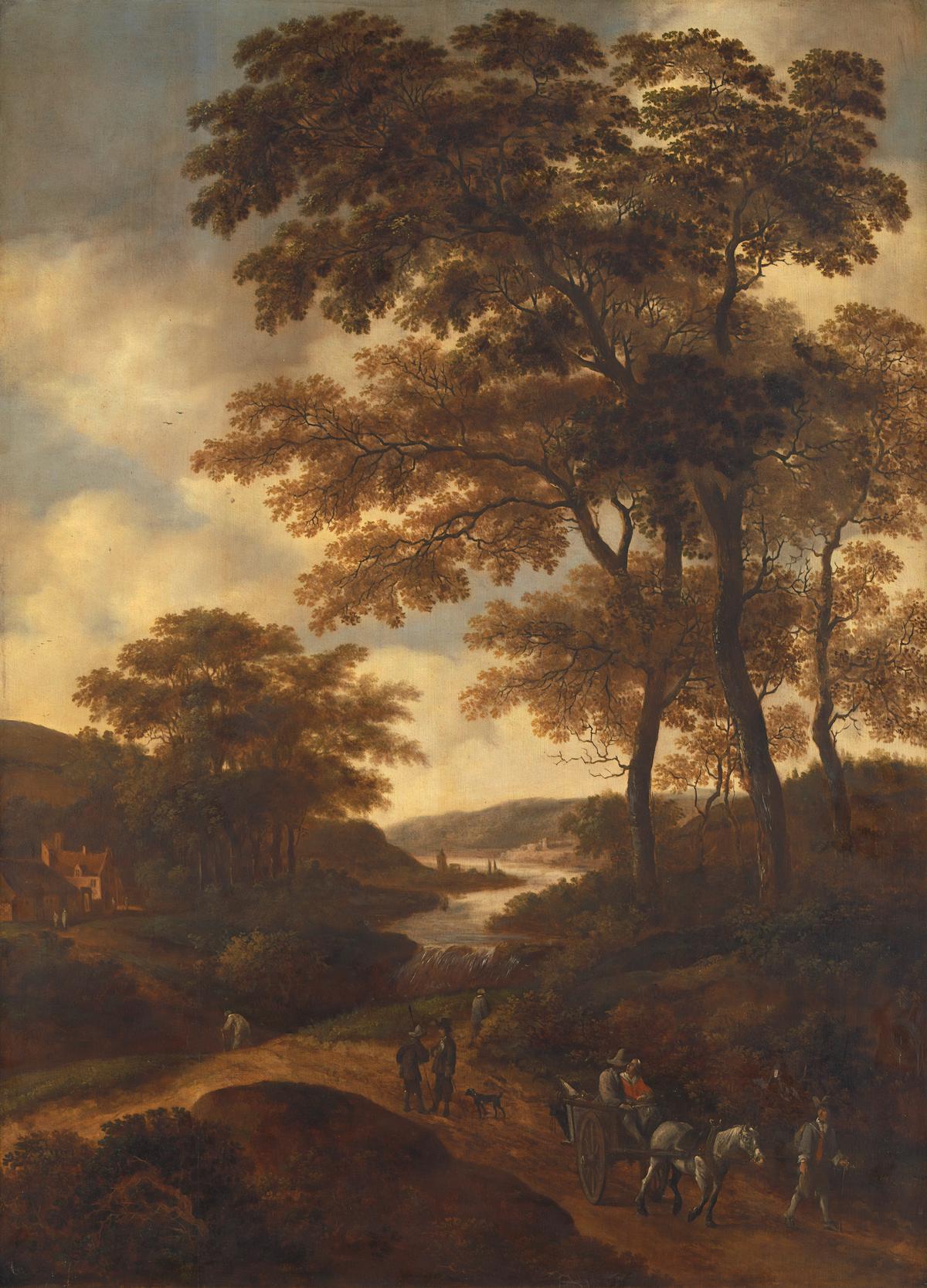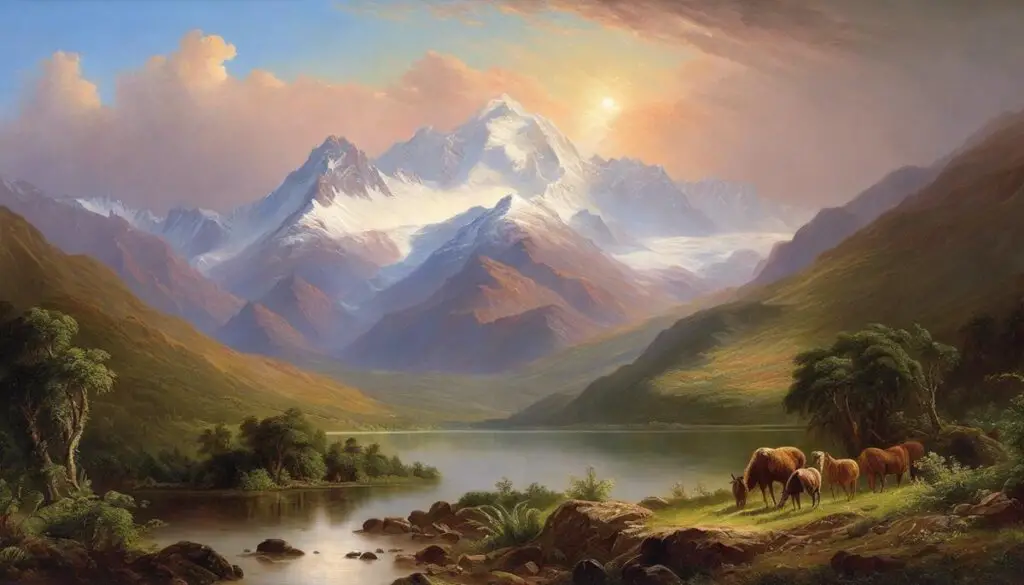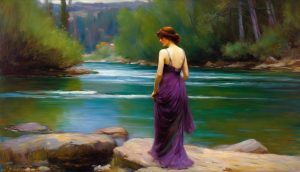During the mid-19th Century, a monumental piece of art made history, hailed as one of the finest exemplars of American landscape painting – Frederic Edwin Church’s magnum opus, the ‘Heart of the Andes’. Born in the crucible of a complex tapestry of social, economic, and political maelström, the work of art encapsulates a fascinating epoch in human history. The painting’s intricate play on colour, perspective, and Church’s refined technique, coupled with elusive symbolism, offered audiences a refreshing lens through which they perceived, interpreted, and reacted to it. Moreover, the initial reactions, evolving over time, offer intriguing insights into how the painting was originally received and how it persevered in modern art sensibilities.
Historical Context of Heart of the Andes
Journey Through History: Unearthing Influences that Carved the Reception of The Heart of The Andes
Journey with us through the corridors of time as we delve into the stunning history that shaped the reception of Frederic Edwin Church’s renowned masterpiece, The Heart of The Andes. Touted as one of the most distinctive pieces of American landscape art, it is the historical influences that effectually amplified its profound resonance.
Let’s meander down the convoluted path of geopolitical collisions that sparked off the widespread reception of this thought-provoking masterpiece.
Staged at a time when North and South America were emerging as formidable global players, Church’s work encapsulates a time of curiosity and fascination with the New World. The Heart of the Andes was unveiled at a time when the world was intrigued by the topographical and cultural grandeur of South America. This fascination, accentuated by groundbreaking literature and travel accounts, amplified curiosity, leading to eager anticipation for such artistic depictions.
Further fuelling interest was the era’s escalating Imperialism. Britain exhibited immense interest in the South American resources, particularly after the California Gold Rush. This ever-growing interest in territories afar significantly enhanced the canvas’s allure.
Now, tip-toe into the realm of technology. The mid-19th century heralded significant advancements in travel and communication that spurred the growth of a global community. The ease in sharing news and pictures was greater than ever, bestowing an unprecedented accessibility of fine art to the average citizen. There in lay another influential facet that contributed to the overwhelming reception of this painting.
Continuing the journey, one cannot fail to mention the palpable influence of Romantic Movement running concurrently. This movement’s essence was about harnessing emotions, the individual experience, and an appreciation for nature and exotic charm, perfectly encapsulated in The Heart of The Andes.
The crescendo of this walk through history rests in the famous exhibition of this sublime work. Catering to the Victorian interest in experiential art, the exhibition, housed in a darkened room with a curtain backdrop and equipped with opera glasses for detailed viewing, elevated the viewer’s immersive experience. It truly flamed the imaginations of the observers, securing the painting’s place in the annals of art history.
Culminating this fascinating exploration, it becomes apparent that the influences that shaped The Heart of The Andes’ reception are as multifaceted as the brushstrokes that comprise the painting itself. From geopolitical events, technology advances, artistic movements to the presentation style, all these historical elements interwove to form a tapestry that significantly influenced the reception of Frederic Church’s artistic masterpiece. Let these revelations ignite a new-found appreciation for the masterpiece that is The Heart of The Andes. Soak in its beauty, its rawness, and the wealth of history that it represents.

Artistic Elements and Interpretation
Coalescing Colour and Contrast: Unveiling the Heart of The Andes
As we delve further into the visual power of the Heart of the Andes, it becomes evident how Frederic Edwin Church’s keen understanding of colour, depth, and detail provoked a surge of reactions amongst its viewers. Markedly absent from our previous discussions, these artistic elements beckon a closer look, shedding new light on the allure of this grand painting.
Colour, an essential ingredient in the palette of a painting, is used dramatically in Heart of the Andes to guide the observer. Oscillating between warm hues that create a sense of tranquil sunlight and cooler tones that push elements into the distance, the palette lends a veritable depth to the landscape. The masterful balance of complementary colours and tonal contrast also invites the viewer on a mesmerising journey across the stunning South American terrain.
Simultaneously, it’s the painstaking attention to minute detail that further augments the appeal of the Heart of the Andes. A tableau vivant of South America, it features a multitude of flora, fauna, and true-to-life elements like water droplets on leaves. Even tiny human figures are wrought with an impressive accuracy that pulls the viewers’ attention, enticing them to explore each nook of the painting with ardent fascination.
Contrast, the third vital force behind the extraordinary reaction to Heart of the Andes, weaves drama into the scene. Skilfully juxtaposing an untouched wilderness against the hints of human interference, Church intensifies the emotional impact. Veering from high peaks to the low valleys, he presents a visual spectacle of light and shadow, a testament to Church’s admiration for the sublime in nature.
Furthermore, Church made a rather innovative use of spatial composition. The painting derails from the traditional linear perspective, instead employing a panoramic view. This sweeping scope mirrors the vast expanse of the South American landscape, engendering an immersive experience for the beholder. The sheer breadth of the canvas, compared to its relatively lesser height, also echoes a theatre screen, maintaining the audience’s enraptured attention.
The Heart of the Andes, then, offers a splendid blend of artistic elements and techniques. Colour, detail, contrast, and compositional creativity all contribute to the magnetic pull of this masterpiece. As viewers we are transported, compelled to lose ourselves in the lush greens, gentling flowing streams and hauntingly majestic mountains. The essence of the painting, beyond the strokes of the brush, becomes a visual narrative – a story of a far-off land, shared in the language of art and beauty. A testament to its enduring relevance, Church’s magnum opus continues to reverberate through the halls of art history, forever the beacon of his adept mastery and vivid imagination.

Public and Critical Reception
Title: “Heart of the Andes: A Reverberating Applause from the 19th Century Art Scene”
Flickering the lamp of our collective memory, we journey back to 1859, when American artist Frederic Edwin Church unveiled his masterpiece, “Heart of the Andes.” Igniting a phenomenal response from critics and the public alike, the reception of this fascinating artwork is an intriguing narrative in itself.
In harmony with the primed anticipation for this prodigious piece, the unveiling occurred in a customised environment mimicking a church interior. This intuitive showcase of his mesmerising artwork garnered immediate acclaim, with queues snaking round the block. It cinematically bridged the gap between the audience’s reality and the exotic unfamiliarity of the scene presented.
Upon first encounter, one might argue the captivating panorama left the audience spellbound. One distinguished critic of the time, Henry Tuckerman, penned the magic of the painting’s technique, immortalising it by asserting, “We know of no canvas that can convey a more comprehensive impression of the boundless diversity, wealth, and majesty of nature in her most secluded and sublime retreats.”
Zooming in on the price tag, “Heart of the Andes” secured a whopping $10,000 during its sale to British landscape enthusiast Edward Stebbins. Undoubtedly, this record-setting price was a direct reflection of the intense admiration bestowed upon the painting, exemplifying the considerable monetary value tied to its brilliance.
Wagering on its success as an artistic spectacle, Church took a rather novel approach – a travelling show. As visitors flocked to appreciate its grandeur, this method cemented its popularity among a geographically diverse audience. Unveiled in cities from New York to London, this strategic move can be seen as a precursor to art tours, unintentionally creating a template for future artistic ventures.
In the critical sphere, response to Church’s masterpiece was abundantly complimentary. Critics praised its meticulous detailing and claimed the work transported the viewer from the urban jungle to the secluded realms of the South American wilderness. Renowned critic John Ruskin lauded Church’s ability to capture the distinct blend of sublimity and beauty, an opinion widely resonated among his peers.
However, like any form of art, “Heart of the Andes” didn’t entirely escape the grip of critique. A handful of voices pointed out its lack of human narrative and the weighty emphasis on landscape detail, reflective of an inclination towards the philosophical rather than the narrative. Nonetheless, these opinions remained largely drowned by the widespread admiration that revolved around it.
As years cascaded into decades, the robust impact of “Heart of the Andes” endures, preserving its place as a shimmering gem in art history’s treasure chest. Regardless of its meteoric critical fame and public popularity at the time of its release, its magic continues to entrance art capacities worldwide, just as it did in its early showcase, encompassing the profound and everlasting influence of Church’s artistic talent.

Photo by europeana on Unsplash
Modern View of the Artwork
Contemporary Reception and Interpretation of ‘Heart of the Andes’
The captivating allure and lasting impact of Frederic Edwin Church’s masterpiece, Heart of the Andes, continues to fascinate audiences, offering a unique interplay of natural beauty and artistic skill. Its blend of wilderness and human subtlety remains relevant to observers, signifying the painting’s enduring relevance and appeal.
In the realm of contemporary art appreciation, one notes a distinct tilt towards acknowledging the power of nature as portrayed in art. Heart of the Andes hits that chord with an uncanny precision, its vibrant colours delivering an immersive experience, pulling the audience into the depths of its scenery.
In a world increasingly conscious of environmental perturbations, Heart of the Andes is perceived as a treasure house of nature’s bounty. The attention to detail in the lush landscape, detailed flora, and intense light effects serve as a critical reminder of biodiverse ecosystems, some of which face peril due to human interference.
Church’s innovative and almost photographic spatial composition further escalates the visual experience. The painting’s large size and detailed examination of a variety of vegetation and geological formations allow for an all-engrossing observation. The sublime depiction of the Andean landscapes creates a visual narrative that seems to transcend through time.
Art connoisseurs today also appreciate the immersive experience Church provides through this work. Using unique painting techniques, he masterfully layers multiple perspectives to create a sense of depth and grandeur, transforming the act of observation into an adventure of visual exploration.
These innovative elements render Heart of the Andes as not merely a painting but an exploration of the relationship between humankind and the environment. Its layered complexity and meticulous detail continue to drive the discourse about the role and influence of nature in art.
Heart of The Andes also plays an integral part in fostering discussions about visual culture and the psychological impact of immersive experiences on audiences. It is intriguing to ponder the painting as a precursor to the contemporary trend of interactive art, borne out in the increasing popularity of installations and digital artworks.
The legacy of Heart of the Andes underscores Church’s rare ability to capture and romanticize foreign landscapes while maintaining an intriguing balance of immaculate detail and profound emotions. This masterpiece unquestionably continues its visual dialogue with contemporary audiences, unravelling new perspectives and stoking the fires of cultural and ecological discourse.

Partly a documentary chronicle, partly an astute commentary, Church’s ‘Heart of the Andes’ captures the spirit of an era, undulating through the flux of time and alterations in critical and public discourse. The analysis of artistic elements, coupled with the understanding of contemporary historical realities, tells a resounding story of its unique reception. Over time, the painting has not lost any of its allure, but has simply donned new layers of interpretations, continually reshaping its reception. Thus, ‘Heart of the Andes’ continues to serve as a rich tapestry inviting audiences to journey into the heart of historical and cultural ebbs and flows, the inexhaustible possibilities of the artistic vision, and the ever-evolving nature of reception.
Recommend0 recommendationsPublished in Uncategorized








Responses